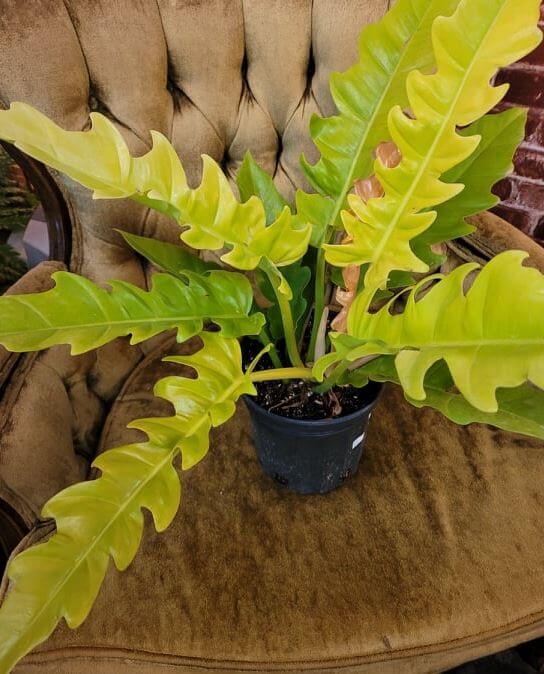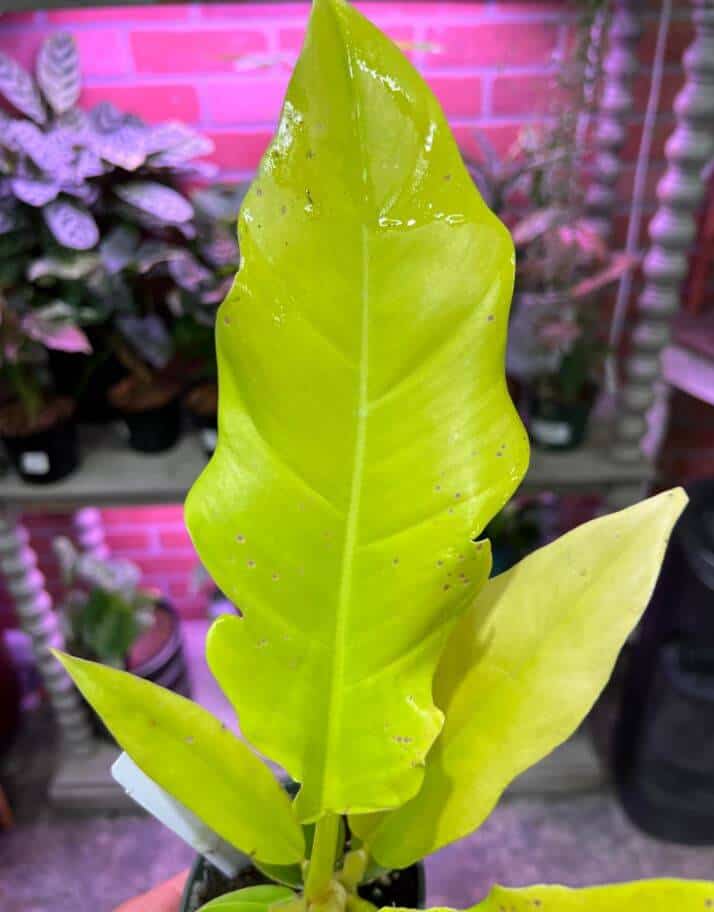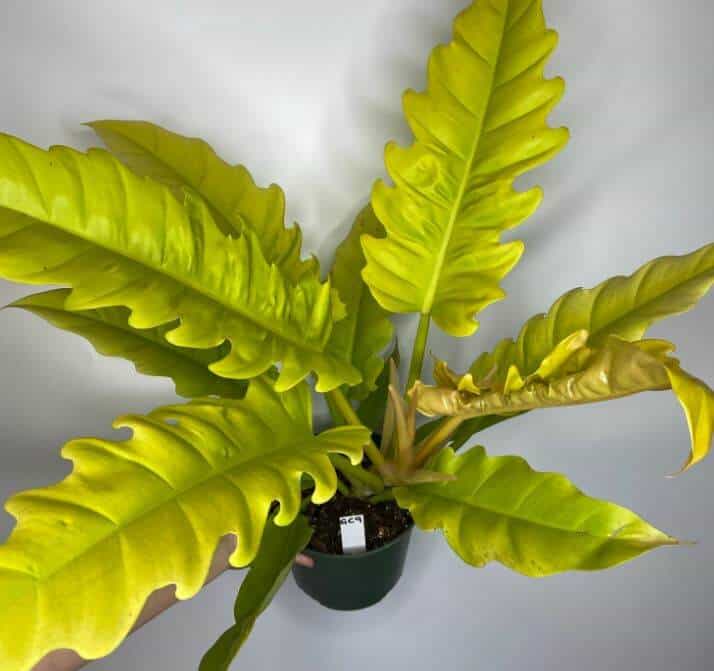Last Updated on September 9, 2023 by a Friendly Gardener
If you’re someone who prides yourself on having rare plants in your garden, the Golden Crocodile plant is a must-have. This striking tropical plant is beloved for its vibrant foliage and uniquely shaped leaves, both of which add a dramatic touch to any garden!
This rare plant requires some upkeep, but once you know what to do, you’ll find that it’s not very hard to add a Golden Crocodile plant to your garden and care for it. Here’s everything you need to know about the Golden Crocodile plant and Golden Crocodile plant care.
Let’s get started!
About the Golden Crocodile Plant

The Golden Crocodile plant, also known as the philodendron Golden Crocodile, is a rare tropical herbaceous plant that stands out with its unique colors and shapes, as mentioned above.
Golden Crocodile plants from the philodendron genus and the Araceae family are a product of breeding the philodendron pinnatifid and melatonin.
Unlike its cousins, this plant variety strayed from the usual heart-shaped leaves that are typical to the genus, instead sporting crocodile-shaped leaves—yep, the plant’s durable, large, evergreen leaves resemble crocodile snouts, earning it its name!
The leaves feature multiple lobes and jagged ends, and are quite long, with a tendency to grow and spread outwards.
Golden Crocodile plants are indigenous to South America and make excellent, attractive indoor plants, with leaves ranging from velvety dark green to glossy golden.
Plant Snapshot
- Maximum Height: Ten feet
- Foliage and Stems: Thick stalks, with shiny, leathery dark green leaves that have golden stripes running through the middle
- Durability: Evergreen, hardy plants
- Dormancy and Growth: During the winter, when leaves brown and shed; new growth occurs again in spring
- Toxicity: Toxic to animals and humans if ingested, due to the presence of insoluble calcium oxalates that irritate the stomach, throat, and mouth; immediate medical attention should be provided if ingested
Caring for the Golden Crocodile Plant

Caring for the Crocodile Gold plant is pretty easy once you get the hang of it. The below guide will help you keep your tropical gem flourishing throughout the year!
Soil and Fertilizer Requirements
The Golden Crocodile plant needs loamy, well-draining soil with pH levels between 6 and 7.5. It’s essential that the soil drains well so that there is no waterlogging as that can lead to root rot, which can eventually kill the plant.
If your soil doesn’t drain well enough, adding sand or perlite to the potting mix will improve its draining capabilities. A mix of perlite, potting mix, and peat, in equal proportions, is a good potting mix for your Golden Crocodile.
Similarly, if the soil is too alkaline, incorporating some peat moss will lower the pH level and make the soil more acidic.
When fertilizing, use a balanced fertilizer with high nitrogen content. Fertilize the plant once every couple of weeks in the growing season (spring) and a slow-release fertilizer once every couple of months otherwise.
Light Requirements
Golden Crocodile plants do well in low-light conditions. The plant thrives in bright, indirect light, but can also survive in low light.
Note that “low light” doesn’t equate to total darkness; indirect sunlight is necessary, and if you’re growing the plant indoors, supplement the existing light source with enough grow lights.
If your lighting setup consists mostly of grow lights, your plant will need at least 14 hours of exposure to grow lights each day.
If you live in a relatively cold area, your plant may be able to withstand direct sunlight, but if you live in an area with a hot climate, avoid keeping your Golden Crocodile in direct sunlight. Prolonged exposure to direct sunlight or light is harmful to the plant, as it can cause the leaves to scorch or brown.
Water Requirements

For adult plants, ensure that the soil dries out before you water it again. When watering, soak the soil fully—stop when you see the water draining out of the pot’s drainage holes.
Even otherwise, as a rule of thumb, stick to watering your plant once every nine or ten days unless you live in a hot region, in which case you’ll need to water it more often.
A good way to judge whether you’re over or underwatering your plant is to watch its leaves. If the leaves turn yellow and brown and then drop off the stalk, you’re overwatering your plant. In this case, reduce the frequency and amount of watering and check the pot’s drainage holes.
During the winters, water only occasionally and only enough to keep the soil moist; the soil shouldn’t dry out entirely.
Temperature and Humidity Requirements
Temperatures between 60℉ and 85℉ are ideal for Golden Crocodiles. If you live in a region that doesn’t see such temperatures for prolonged periods, you may need to add heating lights or place the plant next to a heating vent or radiator.
Humidity levels need to be 60% or higher for Golden Crocodiles. If the environment around the plant is dry, you can place the pot in a pebble-and-water tray, or install a humidifier.
Pruning Requirements
If you don’t have a green thumb, you’re in luck—Golden Crocodiles don’t need much pruning. You may need to prune only when you see leaves yellowing or browning, which you can remedy by cutting back on the water and fertilizer, especially during the plant’s dormant period.
Use sterile shears to prevent any disease or infections from spreading between parts of the plants or from one plant to the other.
Repotting Requirements
Repotting your Golden Crocodile once every couple of years is sufficient. When repotting, upgrade the pot size to the next available size and ensure that it has sufficient drainage holes.
When repotting, do so gently—Golden Crocodiles, much like their animal namesakes, don’t take well to being disturbed!
Propagation

If you want to propagate your Golden Crocodile, stem cuttings work best. Use a cutting that has at least two leaves, and then remove the bottom leaf and dip the end of the cutting in some rooting hormone.
Follow this up by planting the cutting in moistened potting mix in a pot and placing the whole thing in a humid, warm spot. Ensure that you’re keeping the soil moist throughout, and after the cutting takes root (after four to six weeks), you can transplant it.
Diseases and Pests
Golden Crocodiles are quite hardy; they’re very resistant to diseases and pests. However, they may still be susceptible to aphids, spider mites, and mealybugs. You can keep these at bay with insecticides.
Your plant may face root rot as a result of overwatering, so water only when required.
The Bottom Line
Golden Crocodiles are unique, rare plants that add a beautiful green touch to your indoor spaces. Even though it’s rare, it doesn’t require much maintenance, which makes it quite beginner friendly.
Just follow the above steps and you and your plant will stay golden!

